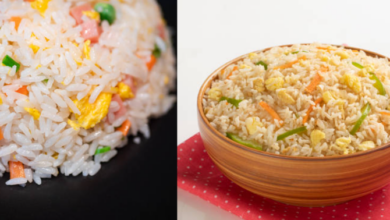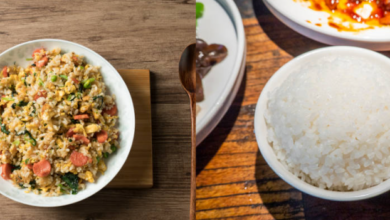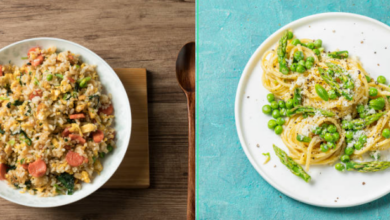Thai Fried Rice Vs. Japanese Fried Rice: Which One is Right for You?

What To Know
- Thai fried rice is typically cooked in a wok over high heat, resulting in a slightly smoky flavor and a characteristic charred texture.
- It is a staple dish served in homes, restaurants, and street stalls across Thailand and is often enjoyed as a main course or as a side dish to accompany other Thai dishes.
- In Japan, variations include yakimeshi (fried rice with chicken and vegetables), omurice (fried rice wrapped in an omelet), and chuka fried rice (a Japanese-style fried rice with Chinese influences).
In the culinary world, fried rice reigns supreme as a versatile dish enjoyed across cultures. Two prominent contenders in the fried rice arena are Thai fried rice and Japanese fried rice, each boasting unique flavors and culinary traditions. Embark on a gastronomic journey as we delve into the intricacies of these two beloved dishes, exploring their distinct ingredients, cooking techniques, and the cultural influences that shape their taste profiles.
A Tale of Two Fried Rice: Thai vs Japanese
1. Ingredients and Flavors
Thai fried rice is characterized by its bold and aromatic flavors, a symphony of spicy, sour, and sweet notes. The foundation of this dish lies in fragrant jasmine rice, stir-fried with a medley of vegetables, proteins, and a flavorful sauce. Common ingredients include garlic, shallots, chili peppers, ginger, and a blend of soy sauce, fish sauce, and oyster sauce. The protein component often consists of chicken, shrimp, or pork, while vegetables like carrots, bell peppers, and green onions add color and texture.
Japanese fried rice, on the other hand, exudes a more delicate and savory flavor profile. It typically utilizes short-grain Japanese rice, known for its sticky texture and ability to absorb flavors. The key ingredients in Japanese fried rice are soy sauce, mirin, and sake, which impart a subtle sweetness and umami flavor. Common additions include vegetables such as carrots, peas, and mushrooms, along with protein sources like chicken, shrimp, or eggs.
2. Cooking Techniques
The preparation methods for Thai and Japanese fried rice showcase distinct techniques. Thai fried rice is typically cooked in a wok over high heat, resulting in a slightly smoky flavor and a characteristic charred texture. The rice is tossed and stirred vigorously to ensure even cooking and to prevent it from sticking.
Japanese fried rice, on the other hand, is typically cooked in a traditional Japanese rice cooker or a frying pan over medium heat. The rice is cooked slowly and gently, allowing the flavors of the ingredients to meld and harmonize. The result is a more cohesive and evenly textured dish with distinct grains of rice.
3. Cultural Influences
Thai fried rice is deeply rooted in Thailand’s culinary heritage, reflecting the country’s vibrant street food culture and the influence of neighboring countries like China and Cambodia. It is a staple dish served in homes, restaurants, and street stalls across Thailand and is often enjoyed as a main course or as a side dish to accompany other Thai dishes.
Japanese fried rice, known as “chahan” in Japanese, has its origins in Chinese fried rice, introduced to Japan during the Meiji period. Over time, Japanese fried rice evolved to incorporate local ingredients and flavors, becoming a popular dish in Japanese cuisine. It is commonly served as a side dish or as a main course, often accompanied by miso soup and pickled vegetables.
Which One Should You Try?
The choice between Thai fried rice and Japanese fried rice ultimately depends on your personal taste preferences. If you enjoy bold, spicy, and aromatic flavors, Thai fried rice is an excellent choice. If you prefer a more subtle and savory flavor profile with a distinct texture, Japanese fried rice might be your go-to dish.
Variations and Regional Differences
Both Thai and Japanese fried rice have numerous variations and regional differences within their respective countries. In Thailand, for example, variations include khao pad saparot (pineapple fried rice), khao pad tom yum (Tom Yum fried rice), and khao pad pu (crab fried rice). In Japan, variations include yakimeshi (fried rice with chicken and vegetables), omurice (fried rice wrapped in an omelet), and chuka fried rice (a Japanese-style fried rice with Chinese influences).
Health Considerations
Both Thai and Japanese fried rice can be part of a balanced diet when consumed in moderation. They provide carbohydrates for energy, protein for building and repairing tissues, and vegetables for essential vitamins and minerals. However, it’s important to note that fried rice dishes can be high in sodium and fat, especially if excessive amounts of oil or salty sauces are used.
The Verdict: A Culinary Tie
In the battle of Thai fried rice vs Japanese fried rice, there is no clear winner. Both dishes offer unique and delicious experiences, each with its own distinct flavors and culinary traditions. The choice between the two ultimately comes down to personal preference and the occasion. Whether you crave the bold and vibrant flavors of Thai fried rice or the subtle and savory notes of Japanese fried rice, both dishes are sure to satisfy your taste buds and leave you craving more.
What People Want to Know
Q: Which type of rice is best for Thai fried rice?
A: Thai fried rice is typically made with fragrant jasmine rice, known for its aromatic and slightly sticky texture.
Q: What are some common vegetables used in Japanese fried rice?
A: Common vegetables used in Japanese fried rice include carrots, peas, mushrooms, and green onions.
Q: Can I use regular soy sauce instead of fish sauce in Thai fried rice?
A: Fish sauce is a key ingredient in Thai fried rice and provides a unique salty and savory flavor. However, if you don’t have fish sauce on hand, you can use regular soy sauce as a substitute.
Q: How can I make my Thai fried rice spicier?
A: To make your Thai fried rice spicier, add more chili peppers or chili paste to the dish. You can also use a hotter variety of chili peppers for a more intense heat.
Q: What are some common protein sources used in Japanese fried rice?
A: Common protein sources used in Japanese fried rice include chicken, shrimp, and eggs.





